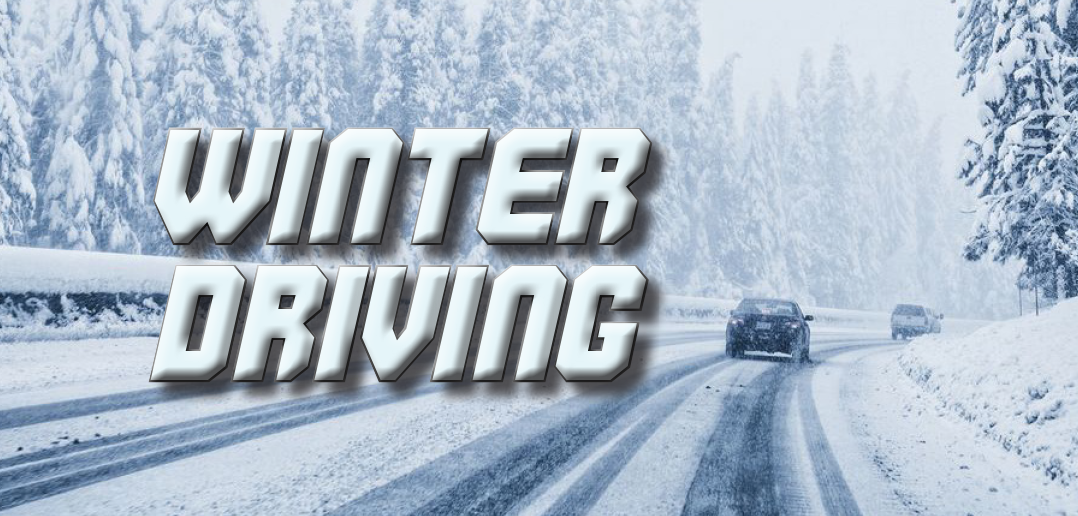Even if you believe yourself to be a pretty experienced driver, winter driving can still have its challenges. It’s easy to forget that winter conditions like ice and snow demand more attention from the driver after months of dry and clear roads. The winter weather can also be brutal to your vehicle, so to learn more about how you can drive safely and maintain your vehicle during this season, we spoke to some local experts in the Lincoln area.
Get Insured
Before you take your ride out onto the winter roads, it is crucial to be sure that you have appropriate insurance to protect you and others on the road from worst-case scenarios. It’s definitely better to know how well you’re covered before you find yourself in a bind. To learn more about this topic, we spoke to Matthew Moorhead, owner of Shelter Insurance Agency (shelterinsurance.com).
“Winter driving in Lincoln is unpredictable, to say the least,” said Matthew. “The university brings in young men and women from all over the country, and some have never had any experience driving on show or ice. A good rule of thumb, in general, is to dress and plan for the worst. Always keep warm shoes or boots, coats, hats, and gloves in your vehicle. On the insurance side, roadside assistance is a good option to have and is included on every Shelter Insurance auto policy up to $100 per occurrence. If you are someone who travels or commutes substantial distances, you can purchase higher amounts.”
If you don’t have adequate liability, uninsured motorist, and underinsured motorist coverage, you can put yourself in a rough place in the event of an accident. Matt is able to walk you through your options if you’re unsure of which insurance route to go, and he can give you some recommendations that fi t your situation. The minimum amount of insurance you have to carry to drive in Nebraska is $25,000 per person in liability and $50,000 per accident of bodily injury coverage—but that doesn’t mean it’s a great level of coverage.
“If you have minimum liability limits and your vehicle is struck by someone who carries only minimum liability, and you were injured—say, break a leg—but need surgery to correct it, it’s not life-threatening, but it can do some damage to your wallet,” Matt said. “In this case, you will have $25K coming from the person who struck you and $25K coming from your underinsured motorist coverage on your policy. I don’t know if you have had surgery lately, but I think it’s a pretty good bet that an ambulance ride, plus hospital stay, surgery, casting, follow-up, physical therapy, and lost wages from work are going to be north of $50K.”
With that scenario in mind, Matt said he recommends that drivers have at least $250K of liability per person and $500K of underinsured motorist coverage per accident—an upgrade that provides 10 times more coverage at a cost of about $5–$10 per month. Whatever amount of coverage, everyone should always practice defensive driving, no matter the season. In the winter, don’t be tempted to drive until the windows defrost, and always be prepared for slippery conditions.
“I can take the time to explain your coverages and the options that are best suited to you,” he said. “If you have ever watched a television commercial where an insurance company tells you to just get online and get a quote, the problem is that as consumers, we have it programmed into our heads that the cheapest price is going to be the best deal. When it comes to insurance, though, you sometimes get what you pay for.”
Advice from an Attorney
We may not be seeing many deer trying to cross the road in Lincoln, but it’s always good to know how to react when one enters our path, especially in the winter. Attorney Susan Napolitano with Berry Law (jsberrylaw.com) gave us some advice:
“The best advice anyone ever gave me is to never leave the road to avoid an animal,” said Susan. “If you have to hit a deer, hit it with one of your headlights – preferably the passenger side so it bounces away from you and into the ditch.”
That’s just the best advice Susan received – she had much more to share with us. To start, always keep your phone put away. Most accidents caused by phones are rear end crashes, which are much harder to avoid in the snow. Unless you are using it for navigation, keep it tucked away to avoid any distractions.
“Always adjust your speed down to account for lower traction when driving on snow or ice,” Susan advised. “Be mindful of every other car on the road. An increased following distance will provide the longer distance needed if you have to stop. Consider proximity to cars in lanes next to you as well. If one of you loses control of the vehicle, it is best not to be side by side.”
If you start sliding, don’t panic. Assess the safest route for your car to move as you slide. Susan explained that a car can be navigated while sliding on ice, but it will feel more like the steering on a bumper car. Always aim for the safest landing area, typically on the side of the road.
“Do your best not to leave the shoulder of the road, but if you do, do not attempt to get back on the road. Overcorrection can be deadly,” Susan warned. “You are already off the road, now is not the time to slide back on. Stay calm and get your car to a clean stop. Once you have stopped, turn on your hazards, assess whether you are in a safe place based on traffic flow, and call AAA.”
If you find yourself in a car accident this winter, give the attorneys at Berry Law a call for a consultation. They can assist you in pursuing compensation to make up for medical costs, lost income, and future needs.
Tires and More!
T.O. Haas Tire & Auto (tohaastire.com) has been a tradition of trust since 1947. They sell more than two dozen brands of tires and perform many automotive services important to safe winter driving, including oil changes, alignments, brakes, exhaust, shocks, struts, cooling systems, transmission-fluid flushes, and more. We spoke to Marketing Manager Fred Knight about the ways that T.O. Haas can help you gear up for winter driving.
“We offer free inspections to make sure your vehicle is ready for the harsh winter weather,” Fred said. “We’ll check your battery, belts, hoses, fluids, lighting, and much more.”
For things you can do yourself, Fred recommended topping off washer fluid, as well as conducting a visual inspection of your belts, hoses, windshield wipers, interior and exterior lighting, and tire condition and pressure. Most repair shops will inspect, for free, the strength and proper charging of your battery, anti-freeze condition and proper ratio, and exhaust leaks in the event that you fi nd yourself stranded.
“The main reason people get stranded in winter is because many don’t realize how bad the roads are until they are stuck,” explained Fred. “Once you’re stuck, it can be extremely difficult to get out. 4-wheel drive and all-wheel drive vehicles provide an advantage but if you fi nd yourself in this situation, you can try placing your floor mats under the drive axle tires to keep them from spinning on snow or ice. Another reason people fi nd themselves stranded is because of a dead battery. As the temperature drops your vehicle oils and fluids become much stiffer. A weak battery will not have the power needed to turn the engine over, so it is important to get your battery checked before you fi nd yourself in this situation.”
Driving on ice is difficult and dangerous, even for the best drivers. New tires will always provide an advantage – especially the newer “ice tires” which use a combination of sticky rubber compounds and a significant number of sipes in the tread design. These sipes act like tiny suction cups to help grip the ice better than traditional tread designs. T.O. Haas can help you fi nd the best tires to help you drive safely this winter.
Fred offered one last piece of advice to keep you safe this winter that is easy to follow:
“Keep your gas tank at least half full,” said Fred. “A full tank reduces condensation, which can lead to gas lines freezing. If you do get stranded, you may need a full tank to keep the engine on 10 minutes each hour in order to stay warm!”
Keep it Clean
One of the easiest ways to keep your car in its best condition is by keeping it clean with regular washes, especially through the winter months. A great place to maintain a spotless ride is the locally owned and operated JetSplash Car Wash (jetsplash.com). JetSplash is the only wash in Lincoln that both hand preps and hand dries your vehicle, making them a great choice to guarantee a clean finish.
“We offer our JetGloss product to add a two-step ceramic coating on your vehicle,” said Sales Manager Kendra McDonald. “It will protect your vehicle from the salt and brine on the roads, as well as create a shiny, glossy fi nish on your vehicle with more water repellency.”
JetSplash offers four different levels of washes ranging from $9 to $20, and they take no more than five minutes so that you can quickly get back on the road. All washes come with a free mat cleaner, vacuums, and air, so you can keep your ride looking great on the inside, too.
“We also have an unlimited program, which is a great winter investment with all the salt that gets put on the roads this time of year,” said Kendra. “You don’t want to leave salt or brine on your vehicle for too long because it will cause rust over time. Our unlimited program allows you to wash your vehicle anytime you want. You don’t need to predict the weather, either; if it snows, just come back in and get another wash!”
Jet Splash has six locations across Lincoln – with one more on the way – so you can keep your vehicle clean and protected wherever you are at.
Winterize Your Wheels
Winter driving can be more dangerous than other seasons for several reasons. To start with the obvious, weather like snow, ice, and sleet can cause poor visibility and slick road conditions. In addition to this, if something were to go wrong, such as an accident or a vehicle breakdown, having to handle it in the cold isn’t just inconvenient, but also dangerous. This is why Sherri Stock, owner of inMOTION Auto Care (inmotionautocare.com), told us it is best to be prepared.
“Winterizing a vehicle these days really means getting the oil changed and completing a good, thorough inspection to get a clear idea of any potential problems,” explained Sherri. “Bad batteries, hoses, belts, water pumps, spark plug wires, etc. can cause a car to break down. Getting repairs and maintenance done now will greatly reduce the chance of breakdowns and being left on the roadside later.”
Another important task Sherri suggested for cold weather is to check tire pressure regularly. Tire pressure monitors are standard on all 2008 and newer models, but if you have a car older than 2008, you should be checking your tire pressure about once a week.
“Tire pressure drops by one PSI, or pounds per square inch, for every 10 degrees the temperature drops,” said Sherri. “Air inside the tire condenses and takes up less space when it’s cold.”
When you visit inMOTION Auto Care, their goal is to deliver the best auto repair and maintenance customer-service experience possible. With a team that includes highly skilled auto mechanics, they are doing precisely that. You can count on them to maintain the highest level of integrity and professionalism throughout your service process, no matter how big or small the job. They are dedicated to your safety and to extending the life of your vehicle, in winter and year-round.
Vehicle Repair
In the unfortunate event of a winter collision, the first concern is the condition and safety of all people involved. The next thing that often comes to mind is the condition of your vehicle. Consider contacting Midtown Body & Paint (midtownbodyandpaint.com). With more than 70 years of providing Lincoln with excellent auto-body repair, quality frame work, full painting services, paintless dent repair, and glass replacement for all makes and models of vehicles, Midtown’s technicians always stay current with quick and meaningful technological advancements in the industry. They take pride in their work and have a stellar reputation for providing high-quality repairs and service that develop lasting relationships. We wanted to learn what advice Midtown had to share about preparing for driving in winter weather, so we spoke to Dan Pape, owner and operator, to hear some safety tips.
“Tires are always a good thing to check,” he said. “If you’re seeing the wear indicators on your tires, you should have them replaced to prevent traction loss and hydroplaning. If your battery is old and weak, cold temperatures can leave you stranded. Also make sure to keep the underside of your car clean through an undercarriage carwash to prevent the corrosion caused by salt and other ice melting agents on the road.”
If you aren’t sure whether or not your vehicle is in good condition, Dan invites you to give Midtown Body a call. Above all, he encourages drivers to keep their vehicles in top shape and use safe driving practices on the road.
Tracy’s Collision Center (tracysbodyshop.com) uses a customer-focused approach to collision repair. The family-owned business has deep roots in Lincoln, with services including painting, frame repair, wheel alignments, and paintless dent repair. For 50 years, they’ve been putting drivers back on the road safely. To learn more about how they can prepare us for winter driving, we spoke to Laurie Sain, manager.
“When driving on icy roads, start by slowing it down,” Laurie recommended. “We’re not just talking about how far you push the gas pedal. We’re also talking about how fast you move your hands and feet. A lower-friction road surface means it takes more time for your tires to find grip and change your speed or direction.”
While steering, if you feel the wheel ‘slip’ in your hands, that means the tires don’t have enough available traction to turn that hard, so unwind the wheel until the resistance feels normal. If you try to turn and nothing happens, straighten the wheel back out and slow down with a gentle, brief press of the brake, then try again.
“When driving in the winter, everything takes longer, particularly stopping and turning. So look farther down the road than you usually do and start braking sooner,” said Laurie. “However, no matter how cautious you are, you may still find yourself spinning out of control. If you do, don’t panic; you can regain the upper hand. Turn the wheel in the direction of your slide with a deliberate motion. Don’t give it more than about half a crank. This isn’t instinctual—your brain feels the car slipping in one direction and logically wants to turn in the other direction to fix it—so it can be worthwhile to practice in a snow-covered empty parking lot somewhere.”
A fabulous one-stop shop for all of your vehicle needs is Parkway 66 Service (parkway66lincoln.com). With more than 30 years of experience in the auto industry, Parkway 66 can handle everything you need to keep your car running smoothly and safely throughout the winter months, as well as all of your minor and major auto-repair needs. They are quick, efficient, and committed to providing top-quality workmanship and service that exceeds your expectations. They recommend professional routine maintenance services and offer all winterizing services, from tires to vehicle inspections, brakes, belts and hoses, batteries, radiators, shocks, starters, and more.
Winter driving can be intimidating and scary, but Lincoln has many professionals that can help you get through it. Take the advice from these experts to prepare for winter weather and protect both yourself and your vehicle through these next few months.








